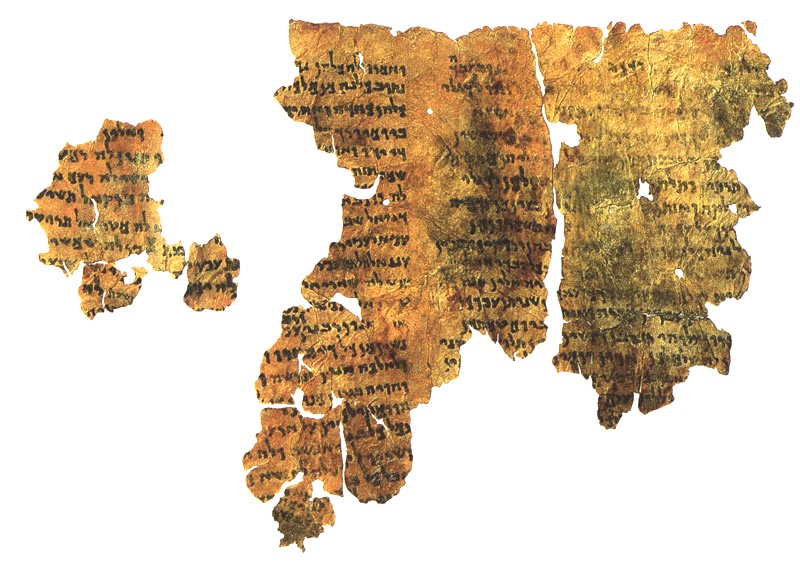
HEBREW SCRIPTS

Pic.1. The Gezer Calendar - 10th century BC.
Paleo-Hebrew script.

Pic.2. The Siloam Inscription - circa 700 BC.
Paleo-Hebrew script.

Pic.3. The Lahish ostracon - 6th century BC.
Paleo-Hebrew script.




Pic.4. Bronze coins from the times of Bar Kohba (132-135 CE)
with Paleo-Hebrew inscriptions

Pic.5. The Temple Scroll from Qumran (11QT).
Second half of the 2nd century BC. Hasmonaean square script.

Pic.6. The War Scroll from Qumran (1QM) - a part of the third column.
Late 1st century BC - early 1st century CE.
Early-Herodian formal square script.

Pic.7. A fragment from the Commentary over Hosea from Qumran. Late 1st century BC.
Herodian semi-formal script.

Pic.8. A fragment from a Letter from Bar Kohba to Yoshua, son of Galgola,
found in Wadi Murabaat (134-135 CE). Post-Herodian script.

Pic.9. Codex Leningradensis. 1010, Cairo/Damascus. Oriental square script


Pic.10. Barcelona Haggadah, 1350. Sefaradic square script.

Pic.11. Gantze Megilla. 14th - 15th century, Germany. Ashkenazic square script

Pic.12. Development of the Paleo-Hebrew script and the Square Jewish script.
1.Phoenician script - inscription from Kara-tepe. (Cylicia, 8th century BC).
2.Moabite stela of king Mesha (circa 850 BC).
3.Paleo-Hebrew script from the 8th century BC.
4.Siloam Inscription (circa 700 BC). 5.Lahish ostracon (6th century BC).
6.Elephantine papyri (circa 400 BC).
7.Contemporary Samaritan script.
8.Temple Scroll from Qumran (2nd century BC).
9.DSS (100 BC). 10.Nabatean script (circa 50 BC).
11.Square Jewish script from the 9th - 10th centuries (Oriental style).
12.Square Jewish script from the 13th - 15th centuries (Sefaradic style).
13.Square Jewish script from the 14th - 15th centuries (Ashkenazic style).
14.Contemporary square Jewish script.

Pic.13. Hebrew letters from 1st century CE ossuary inscriptions (left)
and from the War Scroll from Qumran (right).

Pic.14. The Leviticus Scroll from Qumran (11QpaleoLev). Late 2nd - early 1st centuries BC.
Paleo-Hebrew script.

Pic.15. Contemporary Hebrew Bible (Jerusalem, Koren Publishers, 1984).
A passage from the Book of Isaiah, 45:1.
The Holy Tetragram YHWH, indicated with an arrow, is non-vocalized.
![]()
Pic.16. The Holy Tetragram YHWH, written with Paleo-Hebrew script -
from the Qumran Psalm Scroll (11QPs), circa 30-50 CE.

Pic.17. The Great Isaiah Scroll from Qumran (1QIsaa), 125-100 BC.
The Holy Tetragram YHWH is written with the same Hasmonaean square script
just like the rest of the text.

Pic.18. The Qumran Psalm Scroll (11QPs), circa 30-50 CE. A passage from Psalm 118:59-64.
The Divine Name is written with Paleo-Hebrew letters, unlike the rest of the text,
for which it is used Herodian square script.

Pic.19. A Commentary over Habakuk from Qumran (1QpHab), 10:7-8. 30-1 BC.
The Divine Name is written with Paleo-Hebrew letters,
in contrast with the Herodian square script of the document.

Pic.20. A Greek text of the Septuagint, found near Nahal Hever. 1st century CE.
A passage from the Book of Zahariah 9:1-2.
For typing the Holy Tetragram it had been used Paleo-Hebrew script.

Pic.21. A Chart of Early Jewish Scripts (according to Frank Cross)
The evolution of the Formal Hand in the Hasmonaean and Herodian Periods.
Line 1. A script transitional between the Archaic (Proto-Jewish) and Hasmonaean periods (circa 175-150 BCE). From a manuscript of Deuteronomy from Qumran (4QDeuta). Published by Sidnie White in: Qumran Cave 4.IX - Discoveries in the Judaean Desert (DJD 14) 7-8+Plate 1.
Line 2. A typical Hasmonaean script (circa 125-100 BCE). From a manuscript of Deuteronomy from Qumran (4Qdeutc). Published by Sidnie White in: Qumran Cave 4.IX (DJD 14) 15-34+Plates 3-9. Compare the hand of the Great Isaiah Scroll (1QIsaa) of about the same date.
Line 3. A Late Hasmonaean or Early Herodian hand (circa 50-25 BCE). From a manuscript of Samuel (4QSama). Cf. F.M.Cross. "A New Biblical Fragment Related to the Original Hebrew Underlying the Septuagint", BASOR 132 (1953) 15-26.
Line 4. A typical Early Herodian formal script (circa 30-1 BCE). From a manuscript of the Order of the War (1QM [1Q33]).
Line 5. An Early Herodian "Round" semi-formal hand (circa 30 BCE - 20 CE). From a manuscript of Numbers (4QNumb). Published by Nathan Jastram in: Qumran Cave 4.VII (DJD 12) 205-67 + Pl.38-49.

Pic.22. The Book of Enoch from Qumran (4QEna). Circa 200-150 BC.
Early Hasmonaean square script.

Pic.23. A Qumran fragment from the Prayer for King Jonathan (4QapPs&Jon). Circa 103 - 76 BC.
Transition from late Hasmonaean to early Herodian script.

Pic.24. Commentary over Habakuk from Qumran (1QpHab). 30-1 BC.
Column 2. Herodian square script, combined with Paleo-Hebrew letters for typing of the Divine Name.

Pic.25. Songs for the Shabbat Sacrifice from Qumran (11QShirShab).
Middle of the 1st century BC. Herodian square script.

Fig.26. A potsherd from Qumran with letters of the Hebrew alphabet.
A scribal exercise.


Pic.27. Inkwells discovered in Khirbet Qumran.


Pic.28. Plaster debris from Qumran and their reconstruction
as scribal benches (according to A.Habermann).

Pic.29. Khirbet Qumran. The Scriptorium.